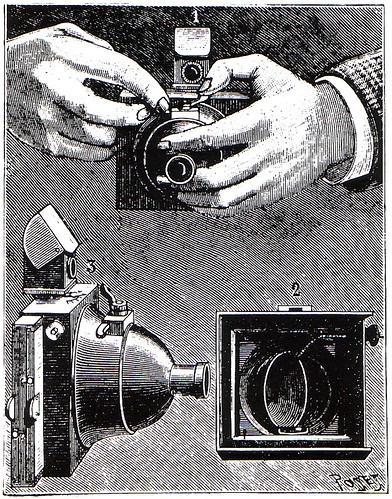Difference between revisions of "Photosphère"
(→Links) |
m (CP>CW + added image_rights. One more link) |
||
| Line 1: | Line 1: | ||
| + | <div class="floatright plainlinks" margin: 0px 0px 10px 15px;"> | ||
{{Flickr_image | {{Flickr_image | ||
| − | |image_source= http://www.flickr.com/photos/89864432@N00/232015255/in/pool- | + | |image_source= http://www.flickr.com/photos/89864432@N00/232015255/in/pool-camerawiki/ |
|image= http://static.flickr.com/92/232015255_01fbdbe618.jpg | |image= http://static.flickr.com/92/232015255_01fbdbe618.jpg | ||
| − | |image_align= | + | |image_align= |
| − | |image_text= Photosphère | + | |image_text= Photosphère. <small>Scan by [[:Category: Image by Uwe Kulick|Uwe Kulick]].</small> |
| + | |image_by= | ||
| + | |image_rights=public domain 1923 | ||
}} | }} | ||
| − | The '''Photosphère''' was a camera designed for | + | </div> |
| + | The '''Photosphère''' was a camera designed for use in tropical regions. Therefore it was made of metal. The shutter was formed like a bowl with a hole and placed inside the characteristic hemispheric frontside of the camera (2). Setting different shutter speeds was possible by clamping a spring (1). Napoléon Conti got the patent on this camera in 1888. About 4000 pieces (all variants together) had been produced. | ||
Different plate magazines were attachable to the camera body's back: a double chassis made of mahagony, a double chassis made of steel, or a magazine for 12 plates made of metal. | Different plate magazines were attachable to the camera body's back: a double chassis made of mahagony, a double chassis made of steel, or a magazine for 12 plates made of metal. | ||
| Line 34: | Line 38: | ||
*Extra: water-level | *Extra: water-level | ||
| − | '''Photosphère n°4 stéréoscopique (2 n°1- | + | '''Photosphère n°4 stéréoscopique (2 n°1-Photosphères in one)''' |
*Type: plate camera | *Type: plate camera | ||
*Films: 18×9cm dry plates | *Films: 18×9cm dry plates | ||
| Line 42: | Line 46: | ||
==Links== | ==Links== | ||
| − | * [http://declic87.free.fr/Pages%20web/Decouverte/Appareil%20collection/appareilphotosphere.htm Photosphère n°1, n°2, n°3, and n°4] at [http://declic87.free.fr/ declic87.free.fr] (French, main source | + | * [http://www.earlyphotography.co.uk/site/entry_C106.html#C106 Photosphère No. 2] at [http://www.earlyphotography.co.uk/ Early Photography] |
| + | * [http://declic87.free.fr/Pages%20web/Decouverte/Appareil%20collection/appareilphotosphere.htm Photosphère n°1, n°2, n°3, and n°4] at [http://declic87.free.fr/ declic87.free.fr] (French, main source of this page) | ||
* [http://www.ukcamera.com/classic_cameras/sph1.htm Other Photosphère variants description] at [http://www.ukcamera.com/classic_cameras/camindexe.html Tigin's Classic Cameras] (German/English) | * [http://www.ukcamera.com/classic_cameras/sph1.htm Other Photosphère variants description] at [http://www.ukcamera.com/classic_cameras/camindexe.html Tigin's Classic Cameras] (German/English) | ||
* [http://johnsrolleionlypage.homestead.com/historicallyimportantcameras.html Page about historically important cameras] at [http://johnsrolleionlypage.homestead.com/ RolleiOnly], with pictures of two different Photosphère variants | * [http://johnsrolleionlypage.homestead.com/historicallyimportantcameras.html Page about historically important cameras] at [http://johnsrolleionlypage.homestead.com/ RolleiOnly], with pictures of two different Photosphère variants | ||
Revision as of 16:16, 26 July 2011

|
| Photosphère. Scan by Uwe Kulick. (Image rights) |
The Photosphère was a camera designed for use in tropical regions. Therefore it was made of metal. The shutter was formed like a bowl with a hole and placed inside the characteristic hemispheric frontside of the camera (2). Setting different shutter speeds was possible by clamping a spring (1). Napoléon Conti got the patent on this camera in 1888. About 4000 pieces (all variants together) had been produced.
Different plate magazines were attachable to the camera body's back: a double chassis made of mahagony, a double chassis made of steel, or a magazine for 12 plates made of metal.
Photosphère n°1
- Type: plate camera
- Manufacturer: Compagnie Française de Photographie
- Year of patent: 1888
- Films: 8×9cm dry plates
- Lens: Cie. Francaise Aplanétique 92mm, or Zeiss Anastigmat 92mm
- Shutter: bowl-like guillotine shutter
- Viewfinder: removeable reflex finder (3)
Photosphère n°2
- Type: plate camera
- Films: 9×12cm dry plates
- Lens: Cie. Francaise double symétrique 125mm, or Zeiss Anastigmat 125mm
- Shutter: bowl-like guillotine shutter, 5 speeds
- Viewfinder: removeable reflex finder
- Image presented in this page of the RolleiOnly website
Photosphère n°3
- Type: roll film camera
- Films: 13×18cm roll film (48 exposures)
- Lens: Cie. Francaise double symétrique 165mm, or Zeiss Anastigmat 165mm
- Shutter: bowl-like guillotine shutter
- Viewfinder: 2 reflex finders inside the camera body
- Extra: water-level
Photosphère n°4 stéréoscopique (2 n°1-Photosphères in one)
- Type: plate camera
- Films: 18×9cm dry plates
- Lens: 2× Cie. Francaise Aplanétique 92mm, or Zeiss Anastigmat 92mm
- Shutter: 2 simultaneous bowl-like guillotine shutters
- Viewfinder: removeable reflex finder
Links
- Photosphère No. 2 at Early Photography
- Photosphère n°1, n°2, n°3, and n°4 at declic87.free.fr (French, main source of this page)
- Other Photosphère variants description at Tigin's Classic Cameras (German/English)
- Page about historically important cameras at RolleiOnly, with pictures of two different Photosphère variants
- Photosphere Price Guide at collectiblend